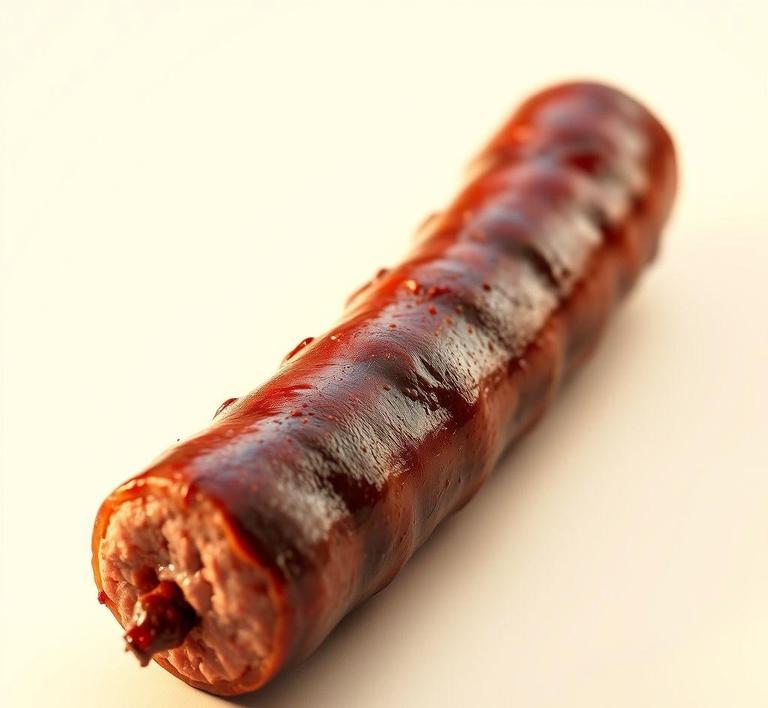If you’ve found yourself with leftover beef smoked sausage and are wondering whether it’s safe or even a good idea to refreeze it, you’re not alone! Refreezing smoked sausage can be a bit tricky, but it’s definitely possible if done correctly. This guide will walk you through the essential steps and tips for safely refreezing beef smoked sausage without compromising its flavor or texture. From proper storage techniques to how to avoid the dreaded freezer burn, we’ve got you covered. Let’s dive in and ensure your sausage stays as delicious as the first time you cooked it!
Can You Refreeze Beef Smoked Sausage?

The short answer is yes, you can refreeze beef smoked sausage, but with important considerations. Smoked sausages, like other meats, are often frozen to extend their shelf life. However, the process of freezing, thawing, and refreezing meat can affect its quality and texture. To understand this better, it’s important to look at how freezing works and what happens during the thawing and refreezing process.
Beef smoked sausage is a cured and cooked product, which means it has already undergone a preservation process. Freezing it after initial preparation or cooking doesn’t pose any immediate risks in terms of safety. The sausages can be safely refrozen if they’ve been properly thawed and handled. However, there are some factors to consider for maintaining the safety and quality of the sausage, which we’ll discuss in more detail below.
How To Refreeze Beef Smoked Sausage?
To successfully refreeze beef smoked sausage without compromising food safety or quality, it’s essential to follow a few guidelines:
- Thaw Safely: When you thaw beef smoked sausage, the best method is to do it in the refrigerator. This allows the sausage to thaw slowly and safely at a consistent temperature, preventing bacteria growth. If you’ve thawed the sausage at room temperature, it’s better not to refreeze it. The sausage may have been in the ‘danger zone’ (40°F-140°F), where bacteria can multiply rapidly, making it unsafe to refreeze.
- Refreeze Promptly: If the beef smoked sausage has been thawed in the fridge, it’s safe to refreeze within a 1-2 day window. This ensures that the sausage stays within safe temperature ranges and doesn’t develop harmful bacteria. If it’s been left out for an extended period (more than 2 hours at room temperature), refreezing is not recommended.
- Packaging: Proper packaging is key to maintaining the quality of the sausage. Wrap the sausage tightly in plastic wrap, foil, or place it in an airtight freezer bag to prevent freezer burn. Freezer burn happens when moisture is lost from the sausage, leading to dry, discolored patches that negatively affect taste and texture. If you plan on refreezing multiple sausages, consider portioning them out to avoid having to thaw the entire package every time.
- Labeling: Always label the package with the date it was first frozen, so you have an idea of how long it’s been in the freezer. This helps prevent keeping it in the freezer too long, which could lead to diminished quality.
- Thawing After Refreezing: When you’re ready to use the refrozen beef smoked sausage, the safest method is to thaw it in the refrigerator again. This slow and consistent thawing ensures that the sausage remains at a safe temperature and prevents any sudden bacterial growth. Avoid thawing at room temperature, as this could compromise food safety.
Quality Impact
While it’s safe to refreeze beef smoked sausage, there can be noticeable impacts on its quality. The texture, flavor, and appearance may degrade slightly, especially if it’s done repeatedly. Here’s a breakdown of the most common effects:
- Texture Changes: Freezing and thawing cause the water inside the sausage to form ice crystals. The ice crystals can rupture the cellular structure of the sausage, leading to a loss of moisture once it’s cooked or reheated. As a result, the sausage may become drier and more crumbly after being refrozen. This is particularly noticeable with sausages that have a higher moisture content.
- Flavor Alterations: Freezing can dull the flavor of sausages, especially if they aren’t properly wrapped. As the sausage is refrozen and thawed, any seasoning or spice blends might lose their potency, resulting in a less flavorful sausage. Additionally, freezer burn (caused by air exposure) can lead to off-flavors or an unpleasant aftertaste, especially if the sausages have been stored for an extended period.
- Appearance: Smoked sausage that has been refrozen may lose some of its vibrant color. The casing may also become tougher or slightly more wrinkled after being subjected to multiple freezing and thawing cycles. While this won’t necessarily affect the taste, the visual appeal might be diminished.
- Fat Separation: If the sausage has a significant fat content, the refreezing process may cause the fat to separate more noticeably. This can result in a greasy texture when cooked, as the fat may not fully integrate back into the sausage. This is particularly true if the sausage was cooked and then frozen, as opposed to raw sausage that’s frozen before cooking.
Refreezing beef smoked sausage is possible, but it does come with certain quality considerations. The most important factor in preserving both safety and taste is ensuring that the sausage is handled correctly throughout the freezing and thawing process. Thawing in the refrigerator, using airtight packaging, and labeling the sausage with dates are simple steps that can make a significant difference in maintaining its quality.
While the sausage will likely remain safe to eat after being refrozen, expect some minor changes in texture, flavor, and appearance. For the best taste and quality, it’s recommended to avoid multiple cycles of freezing and thawing. If you’re someone who frequently buys large quantities of beef smoked sausage, consider dividing it into smaller portions before freezing, so you only thaw what you need.
Ultimately, if you’re okay with slight quality degradation, refreezing beef smoked sausage can be a practical solution. However, for optimal taste and texture, it’s always best to consume it within the initial freezing period and avoid overextending its frozen life.
Is It Safe To Refreeze Beef Smoked Sausage?
Refreezing beef smoked sausage is a topic that often raises questions about safety and quality. The main concern with refreezing any type of meat, including smoked sausage, revolves around the potential for bacterial growth and the loss of texture and flavor. To determine if it’s safe to refreeze beef smoked sausage, it’s important to first understand how freezing and thawing affect the sausage.
When you freeze beef smoked sausage, you’re halting the growth of bacteria, which is why it’s safe in the first place. However, once the sausage is thawed, bacteria can begin to grow again. If you refreeze the sausage without cooking it, you may risk encouraging the growth of harmful bacteria like Salmonella or E. coli, especially if the sausage was left at room temperature for too long during the thawing process. This can lead to foodborne illness, which makes it critical to know the right way to handle the thawing and refreezing process.
The USDA advises that it is safe to refreeze beef smoked sausage only if it has been thawed in the refrigerator, not on the counter or in warm environments. When the sausage is thawed in the fridge, it stays at a safe temperature (below 40°F), which prevents bacteria from multiplying. If you’re planning to refreeze it, ensure that you do so as soon as possible after it has been thawed and not after it has been left out for hours.
Another factor to consider is the quality of the sausage. While refreezing may not necessarily make the sausage unsafe, it can affect the texture and taste. Repeated freezing and thawing cause moisture to be lost in the sausage, which can make it dry and tough once cooked. For this reason, even if it’s safe to refreeze the sausage, you might not enjoy the same flavor and juiciness as before.
Signs That Beef Smoked Sausage Should Not Be Refrozen
There are a few telltale signs that your beef smoked sausage should not be refrozen. These signs are indicators that either the sausage has been mishandled or that it has started to degrade in quality or safety. Here are the key signs to look out for:
- Unpleasant Odor: One of the first signs that your sausage may be unsafe to refreeze is an off or sour smell. This could indicate that bacteria have started to proliferate in the sausage, making it unsafe to eat. When you thaw smoked sausage, always check the aroma before deciding to cook or refreeze it. If it smells rancid, discard it immediately.
- Slimy or Discolored Appearance: If your smoked sausage becomes slimy or changes in color (such as turning gray or green), it has likely been exposed to temperatures that caused bacterial contamination. The presence of these visual changes usually indicates spoilage, making refreezing not only unsafe but also unappetizing.
- Too Long at Room Temperature: If the sausage has been left out at room temperature for more than two hours (or one hour if the ambient temperature is above 90°F), the risk of bacterial growth increases significantly. In this case, it should not be refrozen and should be discarded.
- Leaks or Tears in Packaging: If the sausage has been punctured or the packaging is compromised, it may have been exposed to air, moisture, or contaminants that could lead to spoilage. If you notice any tears in the packaging, it’s best to cook the sausage immediately or dispose of it if it appears to have gone bad.
Common Refreezing Mistakes
When it comes to refreezing beef smoked sausage, there are a number of mistakes people often make that can lead to food safety risks or diminished quality. Here are the most common mistakes to avoid:
- Refreezing After Thawing at Room Temperature: As mentioned earlier, thawing beef smoked sausage at room temperature can be dangerous. If the sausage has been sitting out for a while, it’s best not to refreeze it. Thawing in the refrigerator ensures that the sausage stays at a safe temperature and minimizes bacterial growth.
- Refreezing Multiple Times: Refreezing sausage multiple times can significantly degrade its quality. Each time you freeze and thaw the sausage, moisture is lost, resulting in a drier, tougher texture. This repeated freezing can also lead to a loss of flavor and can make the sausage less enjoyable to eat.
- Not Properly Packaging for Freezing: If you don’t wrap the smoked sausage properly before freezing, it may suffer from freezer burn. Freezer burn occurs when air comes into contact with the sausage, causing dehydration and discoloration. Make sure to wrap the sausage tightly in plastic wrap, aluminum foil, or place it in a vacuum-sealed bag before freezing.
- Thawing and Refreezing Large Amounts: If you thaw a large batch of smoked sausage, it’s easy to overlook how much you’ve actually used. Refreezing the entire batch, even though some portions have been used or thawed, can expose the remaining sausage to contaminants, making it unsafe to refreeze. Instead, portion out the sausage before freezing so you can easily thaw only what you need.
- Ignoring Expiration Dates: Always check the expiration date of the sausage before refreezing it. If the sausage was already near its expiration date when you first froze it, refreezing it won’t prolong its freshness. It’s best to freeze sausage as soon as possible after purchasing it to ensure the best quality.
Tips And Tricks For Refreezing Beef Smoked Sausage
If you decide to refreeze beef smoked sausage, here are a few tips to do it safely while preserving the best possible quality:
- Freeze While Fresh: The best way to preserve beef smoked sausage is to freeze it as soon as possible after purchase. Doing so locks in its freshness and ensures that it will maintain the best texture and flavor when thawed and cooked later.
- Use Airtight Packaging: To prevent freezer burn and preserve the quality of the sausage, wrap it tightly in plastic wrap or aluminum foil. Vacuum-sealing is the best option, as it eliminates air exposure and helps retain moisture and flavor.
- Label and Date: Always label your smoked sausage with the date it was frozen. This helps you keep track of how long it’s been in the freezer, ensuring you consume it before it loses too much quality.
- Thaw in the Refrigerator: If you do need to refreeze the sausage, always thaw it in the refrigerator. Never thaw sausage on the countertop, as it can quickly reach unsafe temperatures that encourage bacteria growth. Plan ahead and allow plenty of time for the sausage to thaw safely.
- Cook Before Refreezing: If you’ve thawed the sausage and don’t plan to use it all, consider cooking the sausage before refreezing it. Cooking the sausage before freezing eliminates the risk of bacterial growth and can help preserve its flavor and texture.
- Portion Control: If you’re uncertain about how much sausage you will use at one time, divide the sausage into smaller portions before freezing. This way, you can defrost only what you need, avoiding the need to refreeze unused portions.
Conclusion
In conclusion, refreezing beef smoked sausage can be safe, but it requires attention to detail. As long as the sausage was thawed properly in the refrigerator and hasn’t been left at room temperature for extended periods, it can be refrozen without compromising safety. However, it’s important to be aware that while refreezing is generally safe, it can have a negative impact on the quality of the sausage. The more times you freeze and thaw the sausage, the more its texture and flavor will suffer.
To avoid common mistakes, such as thawing at room temperature or refreezing multiple times, always take care to handle the sausage correctly. Use airtight packaging, label your freezer items, and consider cooking sausage before refreezing it if you’re uncertain about how soon you’ll use it. By following these guidelines, you can enjoy your smoked sausage without worrying about safety or diminished flavor.


